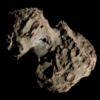astro.wikisort.org - Comet
Comet Giacobini–Zinner (officially designated 21P/Giacobini–Zinner) is a periodic comet in the Solar System. It was discovered by Michel Giacobini, who observed it in the constellation of Aquarius on December 20, 1900. It was recovered two orbits later by Ernst Zinner, while he was observing variable stars near Beta Scuti on October 23, 1913.
 Near 2018 perihelion | |
| Discovery | |
|---|---|
| Discovered by | Michel Giacobini, Ernst Zinner |
| Discovery date | December 20, 1900 |
| Alternative designations | 1900 III; P/1900 Y1; 1913 V; P/1913 U1; 1926 VI; 1933 III; 1940 I; 1946 V; 1959 VIII; 1966 I; 1972 VI; 1979 III; 1985 XIII; 1992 IX |
| Orbital characteristics A | |
| Epoch | March 6, 2006 |
| Aphelion | 6.014 AU |
| Perihelion | 1.038 AU |
| Semi-major axis | 3.526 AU |
| Eccentricity | 0.7056 |
| Orbital period | 6.621 a |
| Inclination | 31.8108° |
| Earth MOID | 0.035 AU (5,200,000 km)[1] |
| Dimensions | 2 km[1] |
| Last perihelion | 2018-Sep-10[1][2] February 11, 2012[3] July 2, 2005[3] |
| Next perihelion | 2025-Mar-25[3] |
The comet nucleus is estimated to be 2.0 kilometers in diameter.[1] During its apparitions, Giacobini–Zinner can reach about the 7-8th magnitude,[4] but in 1946 it underwent a series of outbursts that made it as bright as 5th magnitude. It is the parent body of the Giacobinids meteor shower (also known as the Draconids). The comet currently has a minimum orbit intersection distance to Earth of 0.035 AU (5,200,000 km; 3,300,000 mi).[1]
Giacobini–Zinner was the target of the International Cometary Explorer spacecraft, which passed through its plasma tail on September 11, 1985. Earlier in the same month the comet was observed by the Pioneer Venus Orbiter[5] In addition, Japanese space officials considered redirecting the Sakigake interplanetary probe toward a 1998 encounter with Giacobini–Zinner, but that probe lacked the propellant for the necessary maneuvers and the project was abandoned.
During the apparition of 2018, the optical spectra have revealed the comet is depleted in carbon-chain molecules and carbon dioxide, likely indicating its origin in relatively warm portion of the Solar system.[6]
References
- "JPL Small-Body Database Browser: 21P/Giacobini–Zinner" (last observation:2013-04-01). Jet Propulsion Laboratory. Retrieved 2016-01-10.
- Syuichi Nakano (2012-02-05). "21P/Giacobini-Zinner (NK 2191)". OAA Computing and Minor Planet Sections. Retrieved 2012-02-18.
- MPC
- King, Bob (29 August 2018). "Comet 21P/Giacobini-Zinner Shines in September - Sky & Telescope". Sky & Telescope. Retrieved 15 September 2018.
- Ulivi, Paolo; Harland, David M (2007). Robotic Exploration of the Solar System Part I: The Golden Age 1957-1982. Springer. p. 281. ISBN 9780387493268.
- Shinnaka, Yoshiharu; Kawakita, Hideyo; Tajitsu, Akito (2020). "High-resolution Optical Spectroscopic Observations of Comet 21P/Giacobini–Zinner in its 2018 Apparition". The Astronomical Journal. 159 (5): 203. arXiv:2004.11008. Bibcode:2020AJ....159..203S. doi:10.3847/1538-3881/ab7d34.
External links
- Orbital simulation from JPL (Java) / Horizons Ephemeris
- 21P/Giacobini-Zinner – Seiichi Yoshida @ aerith.net
- 21P at Kronk's Cometography
- Comet 21P - Comet Watch
На других языках
[de] 21P/Giacobini-Zinner
Giacobini-Zinner (offizielle Bezeichnung 21P/Giacobini-Zinner) ist ein kurzperiodischer Komet, der am 11. September 1985 von der Raumsonde ICE (International Cometary Explorer) untersucht wurde. Er ist somit der erste Komet, der jemals von einer Sonde erforscht wurde.- [en] 21P/Giacobini–Zinner
[es] 21P/Giacobini-Zinner
El 21P/Giacobini-Zinner[1] es un cometa cuyo período es de 6,621 años. Las características de su órbita respecto de la órbita terrestre hacen que, de cada dos revoluciones, una de ellas sea favorable para su observación, ya que el cometa pasa entonces relativamente cerca de la Tierra. Esa circunstancia ocurre el 9 o 10 de octubre y entonces se observa la lluvia de meteoros de las Giacobínidas o Dracónidas (llamadas así porque su radiante u origen aparente se sitúa en la constelación del Dragón). El cometa recibe este nombre por sus descubridores, Michel Giacobini y Ernst Zinner, quienes lo avistaron por primera vez el 20 de diciembre de 1900.[ru] 21P/Джакобини — Циннера
Комета Джакобини — Циннера (21P/Giacobini-Zinner) — короткопериодическая комета из семейства Юпитера, которая была открыта 20 декабря 1900 года французским астрономом Мишелем Джакобини в обсерватории Ниццы, когда комета медленно двигалась по созвездию Водолея. Она была описана как диффузный объект 10,5 — 11,0 m звёздной величины с центральной конденсацией яркостью 12,0 m и комой около 1 угловой минуты в поперечнике. Комета обладает довольно коротким периодом обращения вокруг Солнца — чуть более 6,4 года.Другой контент может иметь иную лицензию. Перед использованием материалов сайта WikiSort.org внимательно изучите правила лицензирования конкретных элементов наполнения сайта.
WikiSort.org - проект по пересортировке и дополнению контента Википедии

